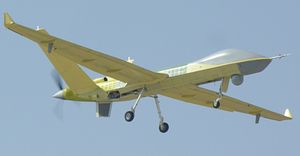The Chinese-designed next-generation medium-altitude long-endurance and strike-capable Wing Loong II (also known as Gongji-2 or GJ-2) unnamed aerial vehicle (UAV) has officially entered service with China’s People’s Liberation Army Air Force (PLAAF), the service revealed at this year’s Airshow China exhibition. The airshow is taking place from November 6 to 11 in Zhuhai in Guangdong province.
“PLAAF officials declined to provide details about the specific configuration and capabilities of the displayed GJ-2 — which bears the serial number 53130 — or the number and distribution of the type, saying only that it offers significantly longer range, endurance, and payload capacity than the previous GJ-1,” IHS Jane’s reported on November 7. “They would also not disclose if the GJ-1 will eventually be phased out in favor of the newer and more capable air vehicles.”
The PLAAF also did not reveal the number of UAVs to enter service in the future.
As I reported in March 2017:
China’s latest strike-capable drone has been designed and developed by the Chengdu Aircraft Design and Research Institute, a subsidiary of [state-owned Aviation Industry Corporation of China (AVIC)] . With an overall length of 11 meters, a wingspan of 20.5 meters, and a height of 4.1 meters, the Wing Loong II UAV was first publicly revealed at the Airshow China 2016 in November 2016…
The Wing Loong II is an upgraded variant of the Wing Loong UAV first introduced into service with the People’s Liberation Army Air Force in 2008. An export version of the drone has been sold to a number of international customers including Egypt, Saudi Arabia, the United Arab Emirates, Nigeria, Uzbekistan, and Kazakhstan. (…) In terms of size and payload, the original Wing Loong combat drone is comparable to the General Atomics MQ-1 Predator, which is slated to be retired by the U.S. Air Force by the end of the year.
Notably, the UAV displayed at this year’s airshow does not feature winglets and was shown equipped with only two hardpoints under each wing. The Wing Loong II UAV successfully completed its first maiden flight on February 27, 2017. Additionally, I noted:
The Wing Loong II UAV can carry a number of different missiles and bombs, including Lan Jian 7 (Blue Arrow 7) laser-guided air-to-surface missiles, TG100 laser/INS/GPS-guided bombs, and the AR-1/HJ-10 anti-tank missile — the Chinese equivalent to the American-made Hellfire missile. Overall, the Wing Loong II can purportedly carry a payload of up to 400 kilograms. The UAV can fly for about 20 hours with a maximum speed of 370 kilometers per hour. The Wing Loong II has an operational radius of 1,500 kilometers.
The UAV has been primarily developed for export and has been marketed by Chinese developers as a cheaper alternative to the MQ-1 Predator. The per-unit price is estimated at around $1-2 million in comparison to, for example, the MQ-9 Reaper’s $30 million.
In March 2017, China announced that Saudi Arabia has expressed interest in procuring up to 300 Wing Loong II UAVs. As I reported in January 2018, the first export customer of the Wing Loong II appears to be the United Arab Emirates. Furthermore, China and Pakistan have reportedly agreed to co-produce 48 UAVs.

































